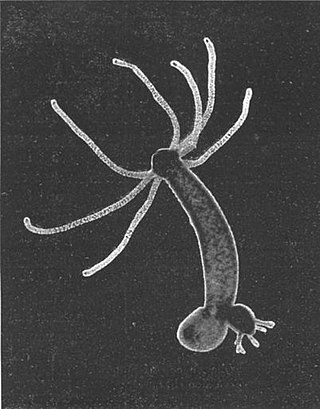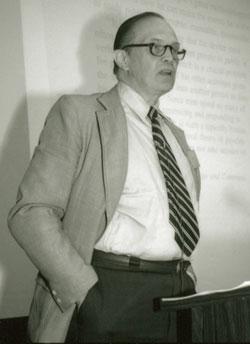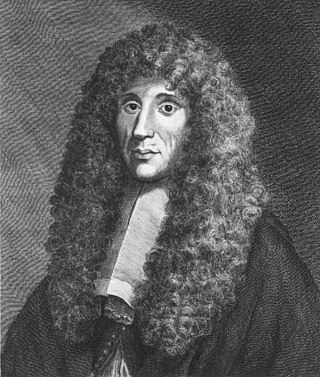Related Research Articles

Genetics is the study of genes, genetic variation, and heredity in organisms. It is an important branch in biology because heredity is vital to organisms' evolution. Gregor Mendel, a Moravian Augustinian friar working in the 19th century in Brno, was the first to study genetics scientifically. Mendel studied "trait inheritance", patterns in the way traits are handed down from parents to offspring over time. He observed that organisms inherit traits by way of discrete "units of inheritance". This term, still used today, is a somewhat ambiguous definition of what is referred to as a gene.

Hydra is a genus of small freshwater organisms of the phylum Cnidaria and class Hydrozoa. They are native to the temperate and tropical regions. The genus was named by Linnaeus in 1758 after the Hydra, which was the many-headed beast defeated by Heracles, as when the animal had a part severed, it would regenerate much like the hydra’s heads. Biologists are especially interested in Hydra because of their regenerative ability; they do not appear to die of old age, or to age at all.

Life is a quality that distinguishes matter that has biological processes, such as signaling and self-sustaining processes, from matter that does not, and is defined by the capacity for growth, reaction to stimuli, metabolism, energy transformation, and reproduction. Various forms of life exist, such as plants, animals, fungi, protists, archaea, and bacteria. Biology is the science that studies life.

Natural selection is the differential survival and reproduction of individuals due to differences in phenotype. It is a key mechanism of evolution, the change in the heritable traits characteristic of a population over generations. Charles Darwin popularised the term "natural selection", contrasting it with artificial selection, which is intentional, whereas natural selection is not.

Reproduction is the biological process by which new individual organisms – "offspring" – are produced from their "parent" or parents. Reproduction is a fundamental feature of all known life; each individual organism exists as the result of reproduction. There are two forms of reproduction: asexual and sexual.

Karl Ludwig von Bertalanffy was an Austrian biologist known as one of the founders of general systems theory (GST). This is an interdisciplinary practice that describes systems with interacting components, applicable to biology, cybernetics and other fields. Bertalanffy proposed that the classical laws of thermodynamics might be applied to closed systems, but not necessarily to "open systems" such as living things. His mathematical model of an organism's growth over time, published in 1934, is still in use today.

Biogeography is the study of the distribution of species and ecosystems in geographic space and through geological time. Organisms and biological communities often vary in a regular fashion along geographic gradients of latitude, elevation, isolation and habitat area. Phytogeography is the branch of biogeography that studies the distribution of plants. Zoogeography is the branch that studies distribution of animals. Mycogeography is the branch that studies distribution of fungi, such as mushrooms.

George Armitage Miller was an American psychologist who was one of the founders of cognitive psychology, and more broadly, of cognitive science. He also contributed to the birth of psycholinguistics. Miller wrote several books and directed the development of WordNet, an online word-linkage database usable by computer programs. He authored the paper, "The Magical Number Seven, Plus or Minus Two," in which he observed that many different experimental findings considered together reveal the presence of an average limit of seven for human short-term memory capacity. This paper is frequently cited by psychologists and in the wider culture. Miller won numerous awards, including the National Medal of Science.

Sexual reproduction is an adaptive feature which is common to almost all multicellular organisms and various unicellular organisms, with some organisms being incapable of asexual reproduction. Currently the adaptive advantage of sexual reproduction is widely regarded as a major unsolved problem in biology. As discussed below, one prominent theory is that sex evolved as an efficient mechanism for producing variation, and this had the advantage of enabling organisms to adapt to changing environments. Another prominent theory, also discussed below, is that a primary advantage of outcrossing sex is the masking of the expression of deleterious mutations. Additional theories concerning the adaptive advantage of sex are also discussed below. Sex does, however, come with a cost. In reproducing asexually, no time nor energy needs to be expended in choosing a mate. And if the environment has not changed, then there may be little reason for variation, as the organism may already be well-adapted. Sex also halves the amount of offspring a given population is able to produce. Sex, however, has evolved as the most prolific means of species branching into the tree of life. Diversification into the phylogenetic tree happens much more rapidly via sexual reproduction than it does by way of asexual reproduction.

Lewis Wolpert was a South African-born British developmental biologist, author, and broadcaster. Wolpert was best known for his French flag model of embryonic development, where he used the French flag as a visual aid to explain how embryonic cells interpret genetic code for expressing characteristics of living organisms and explaining how signalling between cells early in morphogenesis could be used to inform cells with the same genetic regulatory network of their position and role.

A biologist is a scientist who conducts research in biology. Biologists are interested in studying life on Earth, whether it is an individual cell, a multicellular organism, or a community of interacting populations. They usually specialize in a particular branch of biology and have a specific research focus.
Life history theory is an analytical framework designed to study the diversity of life history strategies used by different organisms throughout the world, as well as the causes and results of the variation in their life cycles. It is a theory of biological evolution that seeks to explain aspects of organisms' anatomy and behavior by reference to the way that their life histories—including their reproductive development and behaviors, post-reproductive behaviors, and lifespan —have been shaped by natural selection. A life history strategy is the "age- and stage-specific patterns" and timing of events that make up an organism's life, such as birth, weaning, maturation, death, etc. These events, notably juvenile development, age of sexual maturity, first reproduction, number of offspring and level of parental investment, senescence and death, depend on the physical and ecological environment of the organism.
Biocybernetics is the application of cybernetics to biological science disciplines such as neurology and multicellular systems. Biocybernetics plays a major role in systems biology, seeking to integrate different levels of information to understand how biological systems function. The field of cybernetics itself has origins in biological disciplines such as neurophysiology. Biocybernetics is an abstract science and is a fundamental part of theoretical biology, based upon the principles of systemics. Biocybernetics is a psychological study that aims to understand how the human body functions as a biological system and performs complex mental functions like thought processing, motion, and maintaining homeostasis.(PsychologyDictionary.org)Within this field, many distinct qualities allow for different distinctions within the cybernetic groups such as humans and insects such as beehives and ants. Humans work together but they also have individual thoughts that allow them to act on their own, while worker bees follow the commands of the queen bee. . Although humans often work together, they can also separate from the group and think for themselves.(Gackenbach, J. 2007) A unique example of this within the human sector of biocybernetics would be in society during the colonization period, when Great Britain established their colonies in North America and Australia. Many of the traits and qualities of the mother country were inherited by the colonies, as well as niche qualities that were unique to them based on their areas like language and personality—similar vines and grasses, where the parent plant produces offshoots, spreading from the core. Once the shoots grow their roots and get separated from the mother plant, they will survive independently and be considered their plant. Society is more closely related to plants than to animals since, like plants, there is no distinct separation between parent and offspring. The branching of society is more similar to plant reproduction than to animal reproduction. Humans are a k- selected species that typically have fewer offspring that they nurture for longer periods than r -selected species. It could be argued that when Britain created colonies in regions like North America and Australia, these colonies, once they became independent, should be seen as offspring of British society. Like all children, the colonies inherited many characteristics, such as language, customs and technologies, from their parents, but still developed their own personality. This form of reproduction is most similar to the type of vegetative reproduction used by many plants, such as vines and grasses, where the parent plant produces offshoots, spreading ever further from the core. When such a shoot, once it has produced its own roots, gets separated from the mother plant, it will survive independently and define a new plant. Thus, the growth of society is more like that of plants than like that of the higher animals that we are most familiar with, there is not a clear distinction between a parent and its offspring. Superorganisms are also capable of the so-called "distributed intelligence," a system composed of individual agents with limited intelligence and information. These can pool resources to complete goals beyond the individuals' reach on their own. Similar to the concept of "Game theory." In this concept, individuals and organisms make choices based on the behaviors of the other player to deem the most profitable outcome for them as an individual rather than a group.
The idea of human artifacts being given life has fascinated humankind for at least 3000 years. As seen in tales ranging from Pygmalion to Frankenstein, humanity has long been intrigued by the concept of artificial life.

The global brain is a neuroscience-inspired and futurological vision of the planetary information and communications technology network that interconnects all humans and their technological artifacts. As this network stores ever more information, takes over ever more functions of coordination and communication from traditional organizations, and becomes increasingly intelligent, it increasingly plays the role of a brain for the planet Earth.
R. Michael Roberts is an American biologist who is the Chancellor's Professor Emeritus of Animal sciences and Biochemistry at the University of Missouri. He is a founding co-editor of the Annual Review of Animal Biosciences, first published in 2013.

In biology, evolution is the process of change in all forms of life over generations, and evolutionary biology is the study of how evolution occurs. Biological populations evolve through genetic changes that correspond to changes in the organisms' observable traits. Genetic changes include mutations, which are caused by damage or replication errors in organisms' DNA. As the genetic variation of a population drifts randomly over generations, natural selection gradually leads traits to become more or less common based on the relative reproductive success of organisms with those traits.

Evolutionary thought, the recognition that species change over time and the perceived understanding of how such processes work, has roots in antiquity—in the ideas of the ancient Greeks, Romans, Chinese, Church Fathers as well as in medieval Islamic science. With the beginnings of modern biological taxonomy in the late 17th century, two opposed ideas influenced Western biological thinking: essentialism, the belief that every species has essential characteristics that are unalterable, a concept which had developed from medieval Aristotelian metaphysics, and that fit well with natural theology; and the development of the new anti-Aristotelian approach to modern science: as the Enlightenment progressed, evolutionary cosmology and the mechanical philosophy spread from the physical sciences to natural history. Naturalists began to focus on the variability of species; the emergence of palaeontology with the concept of extinction further undermined static views of nature. In the early 19th century prior to Darwinism, Jean-Baptiste Lamarck (1744–1829) proposed his theory of the transmutation of species, the first fully formed theory of evolution.
The Genetics Society of America (GSA) is a scholarly membership society of more than 5,500 genetics researchers and educators, established in 1931. The Society was formed from the reorganization of the Joint Genetics Sections of the American Society of Zoologists and the Botanical Society of America.

The following outline is provided as an overview of and topical guide to evolution:
References
- ↑ Jacobson, Homer (1958). "On Models of Reproduction". American Scientist. 46 (3): 255–284. JSTOR 27827154.
- ↑ Cornelia Dean (2007-10-25). "'55 'Origin of Life' Paper Is Retracted". New York Times .